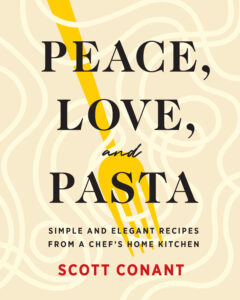An exclusive interview with Chef Conant by Robin Jay
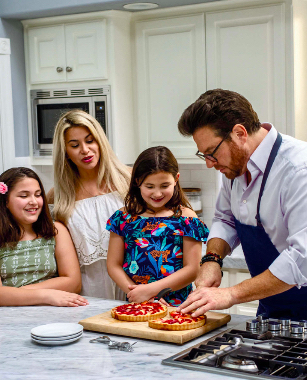
Foodies worldwide know Celebrity Chef Scott Conant as the debonair TV judge on Food Network’s Chopped and Beat Bobby Flay culinary competition shows. The James Beard Award-Winning Chef wows fans with his elevated Italian-American fare at Cellaio Steak in New York, Mora Italian and The Americano in Arizona (coming soon to Atlanta!) And now, home cooks will enjoy Chef Conant’s newest cookbook: ‘Peace, Love & Pasta’, full of the beloved recipes he whips up in his own home with his wife, Meltem, and young daughters, Ayla and Karya.
“Last year’s [pandemic] lockdown definitely created an opportunity to focus
on the cookbook,” Chef Conant shared with Eloquence editor Robin Jay. “I know it was a struggle for a lot of people and I could relate. I’m used to traveling 75 percent of the time for work and suddenly, I was home…a lot. For me, it turned out to be a blessing. With my schedule completely cleared, I wanted to approach that newfound time at home with gratitude. It’s not something that I get very often, frankly, just being able to spend time with my kids. My oldest daughter’s 10th birthday was around the beginning of the pandemic and now she’ll be 12 in a few months. I consider myself lucky to spend this extra time with her and watching her grow during this interesting part of her childhood. I’ve learned a ton – let’s put it that way.”
A Family Cooking Affair
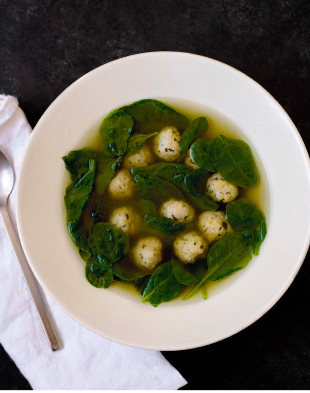
At home during the pandemic provided the Conants ample time to cook as a family, and for Scott to curate a collection of their favorite recipes to share with you and other home cooks in ‘Peace, Love & Pasta’. Time spent together in the kitchen rolling fresh pasta and simmering ‘Mother’s Sunday Sauce’ and Kathy’s Spinach Soup with and Chicken Meatballs’[shown at right, recipe to follow below] alongside his daughters gave way to some very special family story telling.
Earlier on in Conant’s cooking career, life as a chef was uber complicated – complicated schedules, complicated ingredients, complicated recipes. He worked hard and long to make a name for himself as a culinarian. But it was while working in Germany, at Munich’s Hotel Bayerischer Hof, that afforded Chef Conant time to
visit Italy on his days off. And in Italy he experienced an epiphany: cucina rustica, or simplisticItalian home cooking.
The Brilliance of Simplicity
“It was a real light bulb moment: my discovery that rustic, modest, simple dishes could have an elegance that surpassed fussier, more complicated staples of what was then considered fine dining,” Conant penned in Peace, Love & Pasta. “The key, I realized, was in the elevation of simple elements: a beautiful fish cooked in a straight-forward way, or perfectly ripe tomatoes accompanied by only fresh basil, burrata, and extra-virgin olive oil. By the time I returned to New York in the 1990s, I was ready to communicate this message, through
my cooking, to the world.”
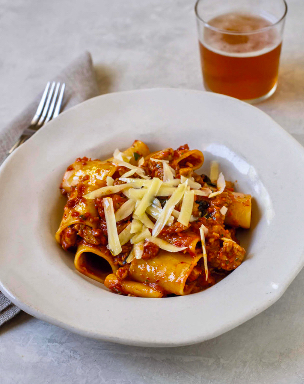
One of many delicious ‘cucina rustica’ recipes in Peace, Love & Pasta is “Paccheri with Pork Ragú and Caciocavallo Cheese” (shown at left, recipe to follow below).
A Turkish Influence
Another “light bulb” moment for Conant happened when he met Meltem and traveled to Turkey to meet her family.
“The first time I had a proper pide [a savory stuffed bread] I was in Turkey, so that was something I wanted to showcase in Peace, Love & Pasta,” said Conant. “The manti recipe, a type of Turkish ravioli, was the first thing that my wife cooked for my parents when she met them. During the recipe testing and photography process for the book, that manti turned out to be the big winner and was everybody’s favorite dish. In hindsight, my wife came in strong when she was cooking
for my parents, and I think that’s really special to share with everyone.”
You’ll find the Conant family’s recipe for manti in Peace, Love & Pasta. Chef Conant also recommends trying these Turkish recipes: Spinach, Feta, and Egg Breakfast Pide (cookbook page 194, shown below) and Eggplant Börek (cookbook page 191).
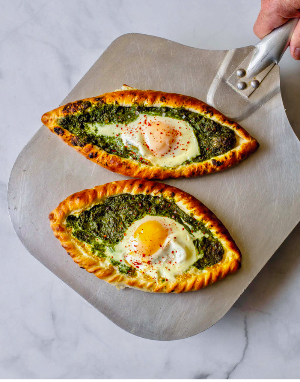
“In my house, it’s not unusual for me to hear banter in Turkish that I don’t fully understand as Mel tries to immerse the girls in their second language,” said Chef Conant in Peace, Love & Pasta. Food is my second language, and I’m trying to make sure my girls become fluent in that as well, by bringing them into the kitchen with me and exposing them to the magical transformation of ingredients through cooking. My hope is that through the recipes in this book, you can do the same.”
How to Receive an Autographed Copy of Peace, Love & Pasta
To order Peace, Love & Pasta signed by Chef Scott Conant, visit www.scottconant.com/books. Unautographed copies are available at Williams-Sonoma, Barnes & Noble, Target and Amazon.com.
Sample Recipes To Try:
KATHY’S SPINACH SOUP WITH CHICKEN MEATBALLS
Prep note: The panko-and-milk mixture needs to rest for 2 hours
before you can make the meatballs.

The Meatballs:
3/4 cup panko
3/4 cup milk
10 ounces ground chicken
1 1/2 tablespoons grated Parmigiano-Reggiano cheese
1 tablespoon chopped fresh parsley
1 1/2 teaspoons chopped fresh rosemary
2 teaspoons kosher salt
Pinch crushed red pepper
1 large egg
Combine the panko and milk in a bowl and let it sit for two
hours at room temperature, then lightly press out excess milk
and discard the soaking liquid. Put the milk-soaked panko in the
bowl of a stand mixer fitted with a paddle attachment. Add the
ground chicken, Parmigiano, ricotta, parsley rosemary, salt, red pepper flakes, and egg and mix at low speed
until the ingredients are just combined. (Do not over mix or the fat from the chicken will start to separate from
the protein.) Cover and place it in the refrigerator overnight.
Line a cookie sheet with parchment paper. Roll out the meatballs to the size of a black olive on the parchment
paper and chill in the refrigerator until the meatballs are cold throughout, about an hour. (You should have about
32 meatballs).
The Soup:
3 to 4 tablespoons Extra-virgin olive oil
4 cups diced yellow onions (from about 2 medium onions)
2 to 3 teaspoons kosher salt, plus more as desired
3 to 4 cloves garlic, minced
2 quarts chicken stock or broth
3 bunches of spinach
1/4 cup grated Parmigiano-Reggiano cheese
2 tablespoons chopped fresh flat-leaf parsley
In a large heavy bottomed pot, heat the olive oil on medium heat. Sweat the onions
in two teaspoons of salt in the olive oil for 2 to 3 minutes, or until the onions are translucent.
Add the minced garlic and continue to cook for about 2 minutes, stirring with a wooden
spoon to make sure the garlic does not burn.
Pour in the chicken broth, raise the heat to medium-high, and bring the soup to a boil,
then carefully drop in the meatballs, and bring the heat back up to a boil. Reduce the
heat to a simmer and cook, uncovered, until the meatballs are cooked through, about
10 minutes. Taste and add an additional teaspoon of salt (or more) if desired.
Stir in the spinach and cook until just wilted. Remove the pot from heat. Serve the soup
immediately, topping each bowl with chopped parsley and some grated Parmigiano-Reggiano.

PACCHERI WITH PORK RAGÚ & CACIOCAVELLO CHEESE
This dish is inspired by the ragús my mother made when we were growing up, but it’s a
slightly stripped own version…Paccheri is a tube-shaped pasta from Southern Italy frequently
used in Neapolitan cooking.
Prep note:The ragú requires a minimum of 2 hours of cooking time and yields more than what you need for the pasta recipe. It is not advised that you halve the recipe, but the unused portion can hold in the freezer in an air-tight container for up to 1 month.
Serves 6
Pork Ragú:
Makes 1 quart
1 pound 5 ounces boneless pork shoulder blade roast (fresh pork butt)
Kosher salt
3 ounces pancetta
1/2 cup minced onion
1/2 cup minced carrot
1/4 cup minced celery
2 cloves garlic, minced
1 (15 ounce) can whole peeled tomatoes, preferably San Marzanos
Pinch crushed red pepper, plus more to taste
2 cups chicken stock, plus additional as needed
5 or 6 fresh basil leaves
Trim and dice the pork butt, then sprinkle it with a little salt. Dice the pancetta.
In a large heavy braising pan or Dutch oven, sear the pieces of pork butt until they are
nicely browned, about 10 minutes. Remove the pork butt and skim off theft.
In the same pot set over low to medium heat, add the pancetta and cook until rendered,
about 5 minutes. Add the onion, carrot, celery and garlic, and continue to cook until
vegetables are caramelized, about 10 minutes. While the vegetables are cooking, squeeze
the tomatoes, then break them up a little bit with your hands. Add the tomatoes and the juice
and cook until the pan is almost dry, about 12 minutes. Add the cubes of pork, the crushed red
pepper, and stock and bring to a boil. (The pork should be submerged, so add extra stock
if needed.) Stir in the basil leaves.
Cover and simmer over low heat for 1 1/2 to 2 hours, until the pork is tender. Skim off the excess
grease, taste, adjust the flavor with salt and crushed red pepper, and prepare with the pasta
according to the directions below. (The extra ragú will last for up to 1 week in the refrigerator, or
it can be frozen and stored for up to 1 month.)

For serving:
1 pound dried paccherri or rigatoni
6 cloves of garlic, thinly sliced
1 tsp. crushed red pepper
1/4 cup extra virgin olive oil
1 tsp. dried oregano
1/4 cup dry white wine
2 cups Pork Ragú (from recipe above)
1 cup pomodoro Sauce (see recipe below)
6 tablespoons unsalted butter
2 tablespoons chopped fresh flat-leaf parsley
6 tablespoons Grate Parmigiano-Reggiano cheese
1/4 cup grated caciocavallo cheese (use the large holes of a box grater)
Bring a pot of heavily salted water to a boil. (The water should have a salinity of broth.)
Add the paccheri. While the pasta is cooking, add the garlic, crushed red pepper, and
extra-virgin olive oil in a sauté pan set over medium heat. Cook until the garlic is slightly
cooked but not dark in color. Add oregano and quickly deglaze the pan with the white wine,
scraping up any bits that have stuck to the bottom of the pan. Add the pork ragú and the
pomodoro sauce. When the pasta is just shy of al dente (after about 75 percent of the cook
time on the package), remove half cup of the pasta cooking water, then drain the paccheri.
(Do not rinse). Add the pasta and a few tablespoons of the pasta cooking water to a sauté
pan, stir to coat, adding additional cooking water to thin the sauce as needed.
Remove from heat then add the butter, parsley and Parmigiano and stir to combine. Divide the
pasta into individual serving bowls and finish each portion with about 3 teaspoons of the shaved
caciocavallo cheese. Serve immediately.
Pomodoro Sauce:
Note: This recipe makes double what you’ll need for the finished dish, but I do not recommend
cutting it down because you need that volume of ingredients to get the flavor right. There are
lots of other uses for the sauce in the book.
5 pounds ripe plum or Roma tomatoes
1 1/2 tsp. Kosher salt, plus more to taste
4 cloves garlic, peeled
1/4 cup extra-virgin olive oil
1 tsp. crushed red pepper
1 cup loosely packed fresh basil leaves
Prepare a pot of boiling water and an ice bath. Core the tomatoes, cut a small x on the bottom,
then blanch the tomatoes in the boiling water for 1 minute and, using a slotted spoon or spider,
transfer them to the ice bath. When cool enough to handle, remove the skins with a paring knife
and discard them. Slice the tomatoes in half and strain through a fine-meshed sieve set over a bowl.
Discard the seeds but reserve the liquid. Combine the deseeded, peeled tomatoes, reserved juice and
salt in a large bowl. Mix the salt into the tomatoes and set aside.
Place the garlic in a saucepan, cover with the olive oil, and cook over very low heat until the garlic
until it is golden and soft, about 20 minutes. (Watch it carefully and shake the pan occasionally to
make sure the garlic doesn’t burn.) Strain and reserve the garlic-infused oil. (Save the garlic for
another use, such as the garlic spread recipe in Peace, Love & Pasta.)
In a large, heavy bottomed stock pot, cook the red pepper flakes in the infused garlic oil over low
heat for about 2 minutes, until the red pepper flakes become fragrant and the flavor starts to bloom.
Add the salted tomatoes and the tomato liquid to the pot and raise the heat to medium-high. Bring
the liquid to a slight boil and skim off the foam that rises to the top. Reduce the heat to medium-low,
and then, using a potato masher, mash the tomatoes very finely as they cook. Simmer until the sauce
is reduced by one-fourth, about 25 to 30 minutes, then taste and adjust the seasoning with salt.
Remove from heat and stir in the basil. Prepare the pasta according to the directions.
Mangia!


